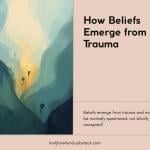
In his book “Is God a Christian?” R. Kirby Godsey, chancellor of Mercer University asks a question that is aimed primarily at Christians of his own southern evangelical background. For this audience he argues, in a series observations about the nature of religion, faith, and Christianity that fear, arrogance, exclusivity, unjustified certainty, and fundamentalism prevent Christians and persons of other faiths from building bridges. His basic thesis is simple: religions (and doctrine in particular) are human creations and should not be absolutized. God is ever beyond any particular religion or religious characterization. Acknowledging this requires that faith as doctrinal certainty be replaced with faith as trust in a covenant commitment to a community of faith, something he sees as characteristic of every religion.
In order to build bridges between religions Godsey offers short characterizations of the religious history and central impetus of Judaism, Islam, Christianity, Hinduism, Buddhism, Confucianism and Taoism. His winsome accounts are intended to draw Christians into different forms of appreciation for non-Christian religions. However, it is here that Godsey’s book becomes problematic. After a long section on Judaism that essentially recounts the Christian Old Testament story Godsey offers a single sentence that illustrates the problem with his approach: “The story of Judaism does not end with the prophets or the Old Testament.” One paragraph then concludes his history, failing to mention the destruction of the temple, the formation of the Talmud, Mishna, and Gemera, the European pogroms, the Holocaust, and the formation of modern Israel. In this author’s experience of dialogue with Jews all of these are at least as important to their self-understanding and representation as the history of Israel in the Jewish Bible. The story of Judaism not only does not end with the Old Testament, it hardly begins there. Godsey’s is an all too Christian understanding of Judaism, even emphasizing the similarities of the school of Hillel with the teaching of Jesus.
But if his is a very Christian representation of Judaism, it is a nearly sub-Christian representation of Christianity. Godsey’s largely unstructured observations, which fall short of an argument, characterize Jesus in a dozen different ways, but inevitably banish any claims concerning his relationship with God to the interiority of the individual believer. He makes no mention of the Trinity, and the relationship of Jesus to the revelation of Father, Son, and Holy Spirit. Yet Christian claims, what Christians pro-claim, are not about Jesus alone. They are about the deepest structures of reality. And this is true of every religion. For a Christian to engage other religions in dialogue it isn’t enough to assign the controversial claim that Jesus is Christ to the realm of personal commitment. It is necessary to show how Christian claims about the deep structure of reality are compatible with the possibility of different religions. It is the kind of task that theologians like Jacque Dupuis (Roman Catholic), Mark Heim (Lutheran), and Schubert Ogden (United Methodist) have engaged in with great subtlety and rigor. And it is the only hope of an inter-religious dialogue that isn’t based on sentimentality.
The problem with his presentation of Christianity are multiplied in his accounts of other religions. One need not be a religious fundamentalist to assert that Islam, Buddhism, Hinduism, Confucianism, and Taoism put forward incompatible claims about the nature of reality, including human nature and human ends. Clifford Geertz offers an anthropological definition of religion that can be helpful here: “(1) a system of symbols which acts to (2) establish powerful, pervasive, and long – lasting moods and motivations in men (3) formulating conceptions of a general order of existence and (4) clothing these conceptions with such an aura of factuality that (5) the moods and motivations seem uniquely realistic.” For religion to function as such in human society it must formulate a conception of a general order of existence within which the moods and motivations of its adherents seem uniquely realistic. This is far from a matter of either mind or heart alone. The continued renewal of a “general order of existence” runs through every aspect of the social life of the religious community.
For this reason religious conversion isn’t simply a commitment to a different community, it is the abandoning of an entire conception of the general order of existence because of its inadequacy, and the adoption of one that is different. It necessarily involves a change of community, but this is by no means all that it involves. This is the reason, which Godsey doesn’t acknowledge, for the urgency and struggle over conversion. The convert isn’t simply someone who adopted a new community. His or her abandonment of the old religion is a direct challenge to its explanatory power and therefore to not only its intellectual assertions, but its political and social status in a religiously plural world. This will not be suffered gladly by the community concerned, as Jesus warned.
To overcome the incomparability of religions, which Godsey at best glancing acknowledges, he offers seven “threads” from which “we can weave a larger and stronger sense of community among our diverse faiths.” These certainly offer some promise for pathways to dialogue, but again Godsey is tripped up by his essentially southern American, Protestant, Christian, individualistic understanding of religion.
It isn’t clear that many forms of Buddhism would affirm that “life cannot be defined solely between the boundaries of life and death.” (Presumably Godsey means “birth and death” or intends “boundary” to be in the singular.) Indeed the language of “boundary” applied to either life or death might be to the Buddhist an example of the ur-illusion of the human mind. The Muslim scholar Sayyid Naguib al-Attas would take exception with saying that Islam faces “a genuine dilemma in the apparent contraction between the notion of a God that is all-knowing and all-powerful and perfectly good.” He believes that the cross of Christ imbues Christianity with an unnecessary and harmful sense of tragedy overcome by the assertion of absolute divine sovereignty. In Taoism applying character traits like “knowing” and “good” to the Tao would be considered delusional. And arguably Christian theologians from John Calvin to John Cobb would say that problem of theodicy in Christianity is a pseudo-problem based on a false metaphysic. With regard to compassion in all religions? Perhaps the Buddhist scholar Edward Conze’s note on Catholic saints will help, “There is not one whom a Buddhist could fully approve. It is not that they were unworthy people, just that they were bad Buddhists.” Even the word compassion has a different meaning in a Buddhist “concept of a general order of existence.”
One could go on in this vein. Godsey has offered, from a Christian perspective, a list of human concerns that may well form the basis for a conversation among some religions. But he has consistently confused universal human challenges with religious framings of those challenges, and the result is less than helpful. His suggestion that we understand faith as covenant commitment rather than unthinking acceptance of dogmatic propositions gives Christians a starting place for engaging in dialogue. But other religious people would certainly have to come to their own decision on this. And finally Godsey needs to acknowledge, and does not, the genuine incomparability of the different religions with which he is concerned.
Acknowledging this would bring a whole new dimension to his central thesis that we each have something to learn from others. Such an acknowledgment forces us to look beyond the fact that Christians can find some similarities with believers in other religious communities. And it forces us to look beyond the fact that God’s truth is found outside the Christian faith – which is orthodox Christian teaching for the last 2000 years. It demands that we accept our own Christian self-understanding as a provisional language in an ever evolving human expression of the reality mediated to us through faith in Christ. That faith, which makes us responsible to a Body of Christ (and its doctrines) that stretches back to the first apostles, also pushes us to follow Christ’s Spirit into the world and engage the religions, the “conceptions of the general order existence” found therein. That engagement may be an engagement with unknown truths precisely because Jesus the Christ is not a divinized human bound by culture and time, but is the second person of the Triune God. Christianity must ever transcend its own self-understanding if it is to be true to its resurrected Lord, who transcends all human conceptions of either humanity or the divine. Godsey’s radical monotheism isn’t radical enough to foster real Christian engagement in inter-religious dialogue. It needs to be Trinitarian.











